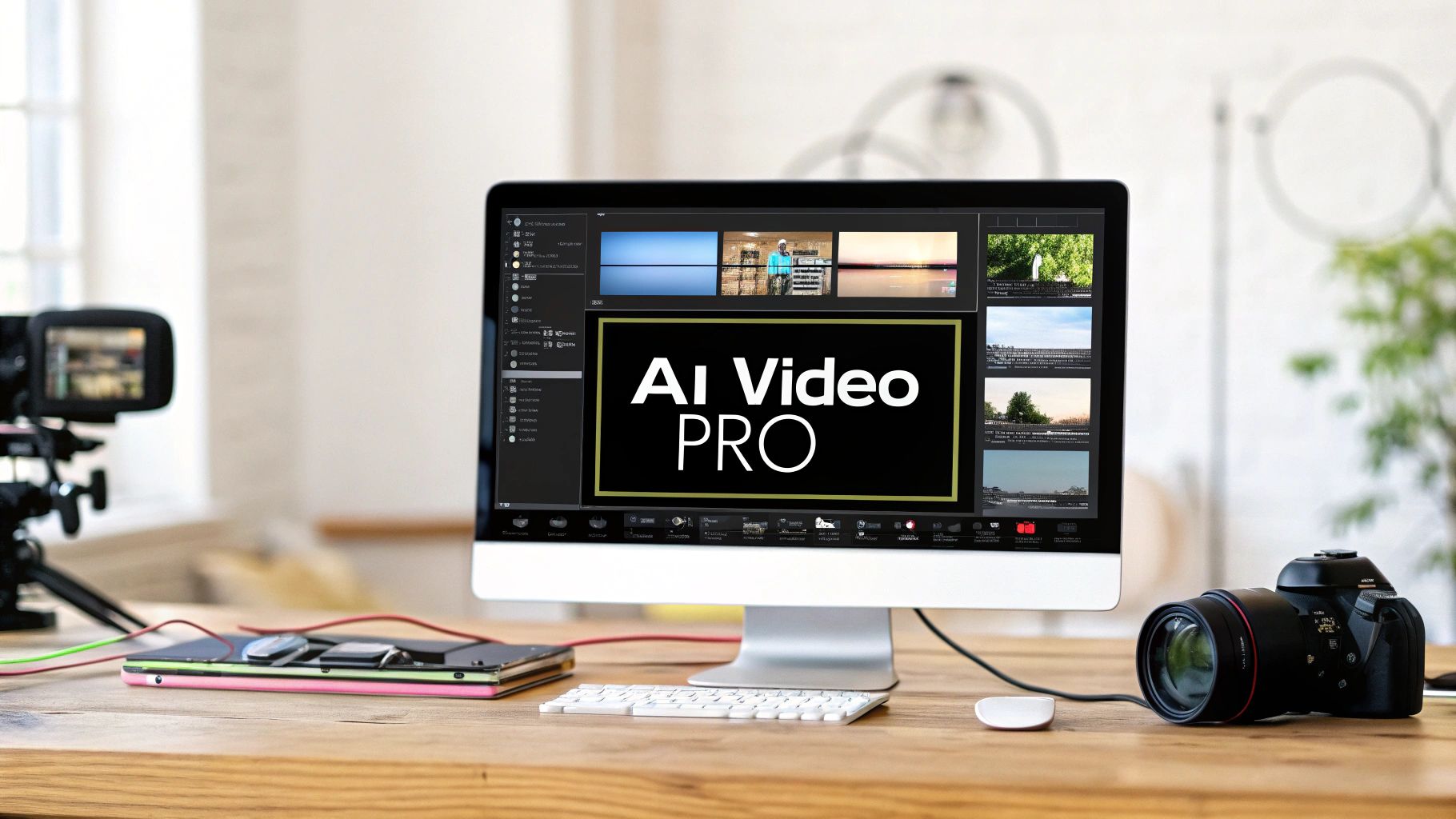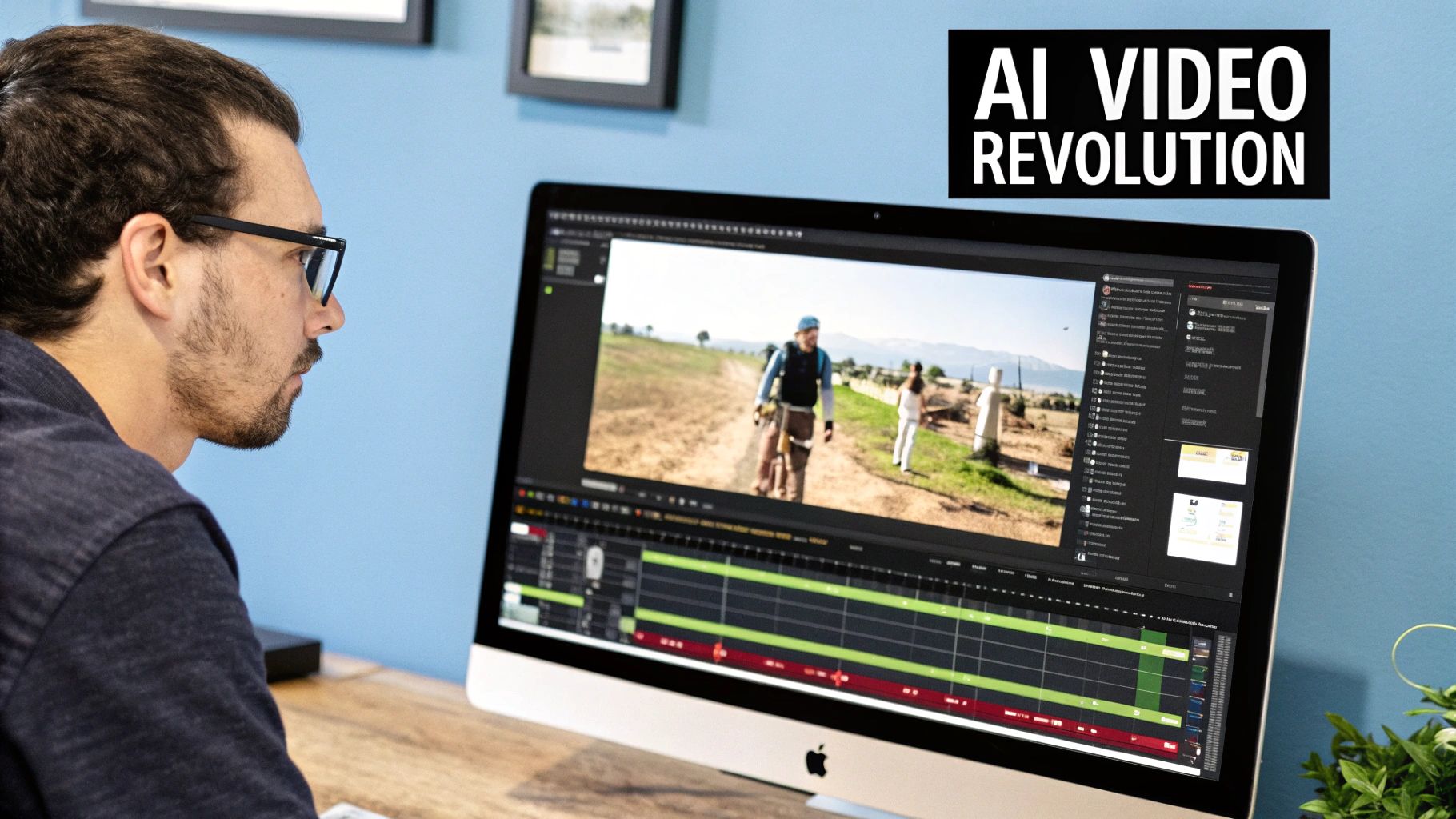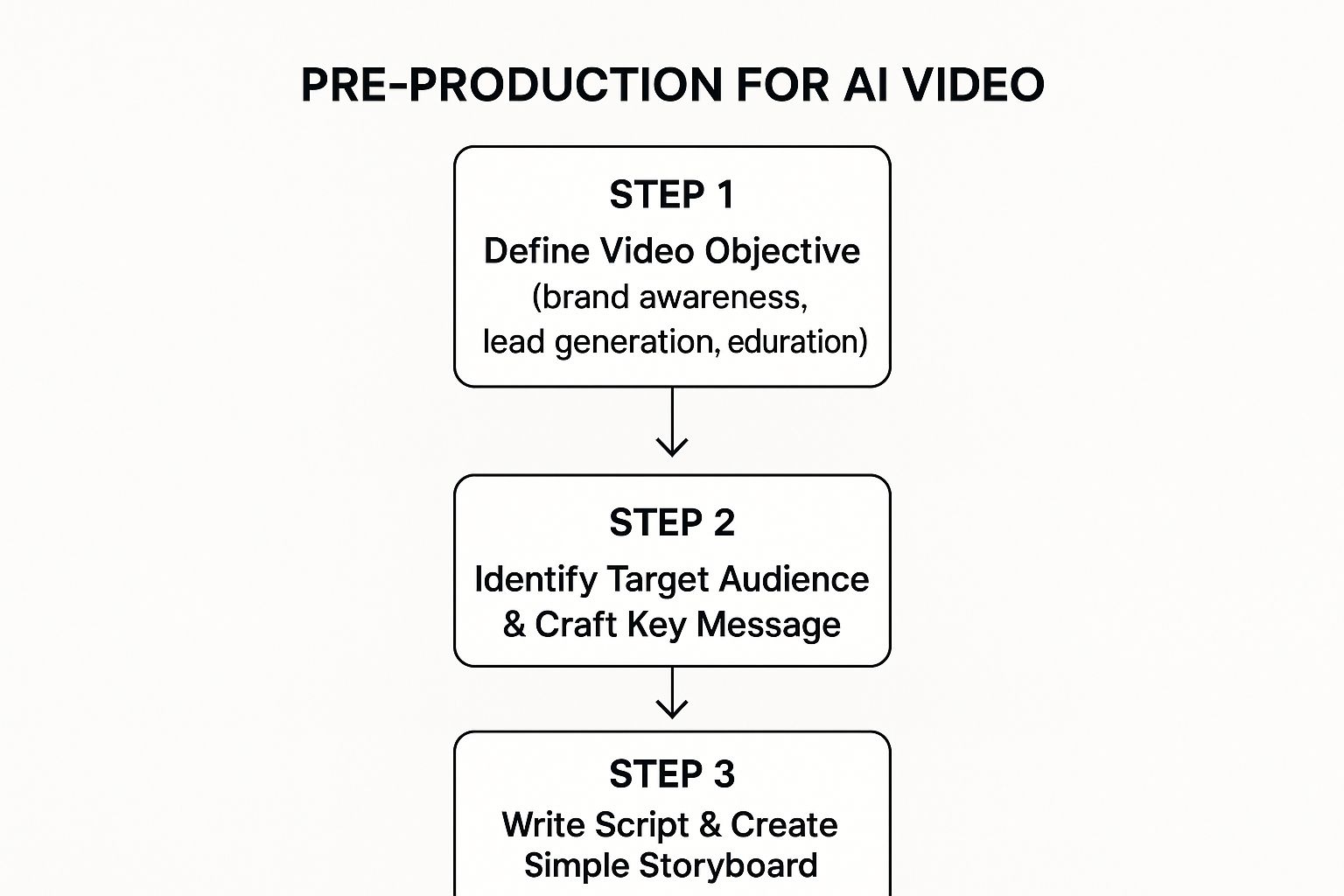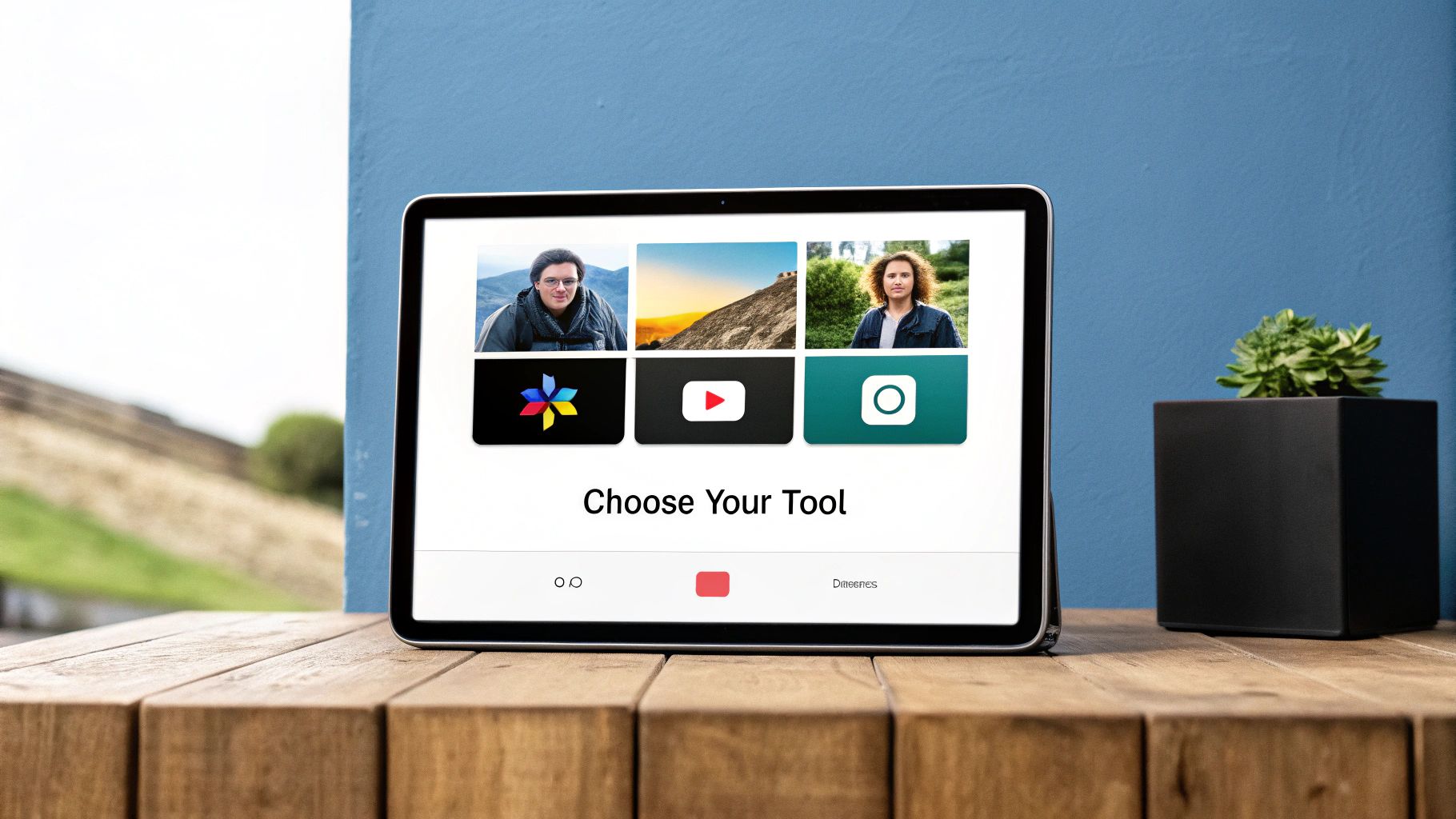
How to Create AI Video Like a Pro
Learn how to create AI video that captivates your audience. This guide provides actionable strategies for scripting, generating, and distributing AI content.
So, what does it actually mean to create an AI video? At its core, you’re using a specialized platform to turn a text script into a fully rendered video—complete with visuals, a voiceover, and even music. It boils down the entire, complex process of traditional video production into a few simple actions: write your message, pick your AI tool, and then polish the final output. It’s an approach that truly puts high-quality video creation in everyone’s hands.
Why AI Is a Game-Changer for Video Content
The world of video production is in the middle of a massive shake-up, and artificial intelligence is leading the charge. This isn't just hype; it's fundamentally changing how we make content, giving anyone the power to create professional-looking videos without needing expensive gear or a film degree.

This shift is fueled by the relentless demand for fast, scalable, and personalized videos for social media, marketing campaigns, and even internal training. Let’s be honest, traditional workflows are just too slow and expensive to keep up. An AI-powered approach, on the other hand, delivers incredible gains in speed and efficiency.
Making Video Production Accessible to Everyone
For years, creating professional video felt out of reach for most small businesses and solo creators. Now, AI tools step in to act as your own digital production crew, handling everything from generating visuals to voicing your scripts.
Think about what this really means:
- No technical skills needed: You don't have to be a video editor or a cinematographer. The software takes care of all the complicated parts.
- Budget-friendly: This approach completely removes the need for pricey cameras, microphones, or studio rentals, slashing production costs.
- Speed to market: You can create a marketing video in minutes, not weeks. That means you can jump on trends while they’re still relevant.
This newfound accessibility has sparked a booming market. To really get a handle on the full scope of what's happening, it helps to understand the broader field of AI content creation.
The global artificial intelligence video market was valued at USD 7.6 billion in 2024 and is projected to explode to around USD 156.57 billion by 2034. This growth shows that AI video is now a core tool for modern creators.
These numbers tell a clear story: AI video isn't just a passing fad; it's becoming an essential asset. By automating the tedious, repetitive tasks, it frees you up to focus on what really matters—strategy and creativity. You can dive deeper into this in our guide to AI-powered content creation.
The result? A much more level playing field where great ideas, not massive budgets, are what truly lead to success.
Building Your Strategic Foundation
Before you even think about opening an AI tool, let's talk strategy. It’s the one thing that separates a video that gets lost in the feed from one that actually makes an impact. I know, the temptation is to jump right in and start generating cool visuals, but trust me on this—the most successful AI videos start with a solid plan.
Without a clear goal, you're just making noise. This whole pre-production process is about making sure your final video tells a story that’s both coherent and compelling.
The infographic below breaks down the simple three-stage workflow that I use as a foundation for every project.

As you can see, the whole thing flows from a single objective. Each step builds on the last, keeping the final video focused and effective.
Clarify Your Core Objective
First things first: what is this video supposed to accomplish? The answer to that question will guide every single decision you make, from the script's tone to the visual style. Don't settle for something vague like "get more engagement." Get specific.
Your objective will probably fall into one of these buckets:
- Boost Brand Awareness: Introduce your brand to new people with something memorable and shareable.
- Generate Leads: Get viewers to sign up for your newsletter, download an ebook, or book a demo.
- Educate Your Audience: Break down a complex topic or show customers how to use your product better.
Knowing your "why" from the very beginning keeps the project on track and ensures you can actually measure the results. This is a critical first step if you're serious about creating an AI video with purpose.
Define Your Viewer and Message
Okay, you’ve got your goal. Now, who are you talking to?
Creating a quick persona for your target viewer helps you craft a message that actually connects with them. Think about their pain points, their interests, and even the kind of language they use.
Understanding your audience is completely non-negotiable for creating content that performs. If you want to dig deeper, we have a detailed guide on how to identify your target audience. This understanding leads you directly to your key message—the one big idea you want the viewer to walk away with.
Key Takeaway: Your message needs to be simple, direct, and tied to your main goal. If you're trying to generate leads, your message has to clearly communicate the value of what you're offering.
Scripting and Storyboarding for AI
With your objective, audience, and message locked in, it's time to write the script. This is the most important instruction you'll give the AI.
A well-written prompt for an AI script generator needs to specify the tone, length, and style. For example, instead of just saying, "Write a script about our new software," try something like, "Write a 60-second, upbeat script for a TikTok video explaining how our new software saves time for busy entrepreneurs." The more specific, the better.
The global AI video generator market is projected to hit USD 2,562.9 million by 2032, and a huge reason for that is how easy these tools have made it to turn simple prompts into full videos. But remember, the quality of your script directly impacts the quality of the AI's output.
Finally, sketch out a simple shot list or storyboard. This doesn't have to be a masterpiece—a few bullet points outlining the key scenes will do the trick. This visual guide helps the AI produce a video with a logical flow, turning a bunch of random clips into a story that actually hooks your audience.
Choosing the Right AI Video Generator

The world of AI video tools is exploding. It feels like a new generator pops up every week, and trying to pick the right one can be paralyzing. The market is already valued at a staggering USD 653.18 million in 2024, and it's on track to more than double.
This boom is no accident. With 86% of businesses now using video as a core marketing tool, the demand for faster, easier creation is off the charts. You can get a deeper look at the industry's explosive growth and what it means for creators by checking out the full video creation tool market analysis on straitsresearch.com.
To cut through the noise, you have to start with your end goal. What kind of video are you actually trying to make? Let’s break down the main categories to help you find the perfect fit.
Understanding the Main Types of Tools
Not all AI video generators are built the same. They generally fall into a few key categories, and knowing the difference is the first step to making a smart choice.
- Text-to-Video Generators: Think of these as your content repurposing machines. Got a blog post or a script? Tools like Pictory or InVideo can turn that text into a video by automatically pulling relevant stock footage and images. They’re perfect for creating quick, faceless social media clips without ever touching a camera.
- Avatar-Based Platforms: Need a presenter but don't want to film yourself? This is where platforms like Synthesia and HeyGen shine. They let you use a digital presenter for corporate training, explainer videos, or marketing updates, giving your content a human touch without the hassle of a real shoot.
- Animation Creators: When you need to explain a complex idea visually, animation is your best friend. Tools like Vyond are designed for this, making it easy to create engaging educational content, product demos, or whiteboard-style explainers that break things down simply.
Figuring out which bucket your project falls into is half the battle. If you want to see a curated list of top performers in each category, check out our guide to the best AI tools for content creators.
AI Video Generator Feature Comparison
To help you visualize the differences, here’s a quick comparison of what each type of tool typically offers. This isn't an exhaustive list, but it gives you a solid starting point for what to expect.
| Feature | Text-to-Video (e.g., Pictory, InVideo) | Avatar-Based (e.g., Synthesia, HeyGen) | Animation (e.g., Vyond) | | :--- | :--- | :--- | :--- | | Primary Use Case | Repurposing text content | Training & marketing videos | Explainer & educational videos | | Visual Style | Stock footage & images | Realistic or stylized AI avatars | 2D animation, whiteboard | | Customization | Scene editing, voiceover choice | Avatar design, voice cloning | Character & asset design | | Best For | Social media, quick content | Corporate communication | Simplifying complex topics |
As you can see, the right tool really depends on the job. A text-to-video generator is fast and efficient for blogs, but an avatar platform offers a more personal, branded touch for corporate needs.
Key Features to Look For
Once you’ve narrowed down the type of tool you need, it’s time to dig into the specific features that will either make your life easier or drive you crazy. Don't get distracted by flashy marketing promises; focus on what actually matters for your workflow.
A great AI video tool isn't just about generating clips; it's a creative partner. The best platforms give you precise control to guide the AI, ensuring the final product reflects your unique vision and brand identity, not a generic template.
Here are the non-negotiable features you should be looking for before you pull out your credit card:
- Voice Cloning: This lets you create a synthetic version of your own voice from a short audio clip. It’s a game-changer for brand consistency and makes your videos feel far more authentic than a generic AI narrator ever could.
- Avatar Customization: If you’re going the avatar route, you need the ability to create a digital presenter that actually looks like it belongs to your brand. Customization is key to standing out.
- Media Libraries: A deep, high-quality library of licensed stock videos, images, and music is essential. This saves you a ton of time and money, and more importantly, keeps you legally protected.
- Multi-Language Support: Need to reach a global audience? Look for tools that can generate voiceovers and on-screen text in multiple languages from a single script. It's the secret to scaling your content internationally without multiplying your workload.
In the end, choosing the right generator comes down to clarity. Figure out exactly what you want your video to do, then go find the tool with the features to make it happen. This focused approach will save you a world of frustration.
Here's the rewritten section, designed to sound like an experienced human expert, following all your specific instructions.
From Prompt to Polished First Draft
Alright, this is where the planning pays off and your ideas start to look like a real video. With a solid script in hand and your AI tool fired up, it’s time to turn your concept into a working draft.
This isn’t just a "push a button and pray" situation. The best results come from treating the AI like a creative partner—you have to guide it to get the magic to happen. Think of it as an incredibly fast, but very literal, assistant. It needs clear instructions to see what you see.
Crafting Prompts That Actually Work
Your script is the skeleton, but your visual prompts are what give the video its soul. If you just dump your script into the generator and hope for the best, you'll probably get a bland, disjointed mess. To make something that really connects, you have to steer the visuals for each and every scene.
For example, don't just ask for "a person working." That's way too vague.
- The Vague Way: "A shot of a busy office."
- The Better Way: "A bright, modern home office with a young entrepreneur smiling at her laptop, a cup of coffee steaming beside her. The mood should feel optimistic and productive."
See the difference? That level of detail tells the AI not just what to show, but how it should feel. This is how you get footage that perfectly matches the tone you’re going for.
The Back-and-Forth of Getting It Right
Let’s be real: your first draft will almost never be the final cut. The real skill in making great AI videos is in the refinement process. You'll need to review, tweak, and regenerate until the video finally clicks.
Don't get frustrated if some scenes are just… off. That’s a totally normal part of the process.
Common First-Draft Fixes You'll Encounter:
- Mismatched Visuals: Maybe the scene is technically correct but the vibe is all wrong. Just regenerate that specific clip with a better, more detailed prompt.
- Weird Pacing: Sometimes the AI will hold a shot for an eternity or cut away way too fast. Jump in and manually adjust the clip durations to create a rhythm that feels natural.
- Robotic Narration: The AI voice might stumble over a word or use a flat, boring tone. Most tools let you tweak the narrator’s delivery, add pauses, or even use phonetic spelling to get it right.
The whole point is to guide the AI. Your job is to give it clear feedback by editing and regenerating, pushing the video closer to your vision with every little adjustment.
Making It Look and Feel Like Your Brand
Before you call the first draft "done," you need to stamp your brand’s personality all over it. This is what separates a generic AI video from a powerful piece of marketing content.
Most professional AI video platforms like ViewPrinter have built-in features for this, and you should absolutely use them.
- Logos & Watermarks: Upload your logo and set it as a watermark. This is non-negotiable for brand recognition, especially when your video gets shared across social media.
- Custom Color Palettes: Ditch the default colors. Apply your brand’s exact hex codes to text, backgrounds, and any on-screen graphics to keep everything looking cohesive.
- Font Selection: Use the same fonts you use on your website and other marketing materials. It’s a small detail that makes a huge difference in looking professional.
Adding these final touches transforms the video from a cool AI creation into a legitimate business asset that builds trust and reinforces who you are.
Final Touches and Smart Distribution

Alright, you've guided the AI to create a solid first draft. But the job isn't done. Generating the video is only half the battle; the real win comes from making sure it actually reaches and engages your audience.
This is where the human touch comes back in. A few simple post-production tweaks can take your video from good to great. I often pull the AI-generated file into a simple video editor to add custom transitions, overlay brand graphics, or even splice in a bit of real footage for a hybrid feel. This final layer of polish makes the content feel uniquely yours.
If you want to get serious about managing this process, check out this AI-Enhanced Post-Production Scheduler Guide to see how you can streamline your workflow from creation to distribution.
Tailor Your Video for Every Platform
One of the biggest mistakes I see people make is posting the exact same video file everywhere. It’s a huge missed opportunity. Each social platform has its own language and preferred format, and if you speak it, you'll see a massive difference in your results.
You absolutely need to create multiple versions of your video.
- TikTok & Instagram Reels: Go vertical with a 9:16 aspect ratio. It fills the entire phone screen, feels native, and stops the scroll. It's a non-negotiable for these platforms.
- YouTube: Stick to the classic widescreen 16:9 format. This is what viewers expect, especially on desktop and TV screens.
- Instagram & Facebook Feeds: A square 1:1 or a slightly taller 4:5 format is your best bet here. These ratios take up more vertical real estate in the feed than a widescreen video, making your content harder to ignore.
Yes, it's a few extra minutes of work, but resizing is a quick task that pays for itself in views and engagement.
The goal isn't just to post content. It's to deliver it in the format that feels most natural and engaging to the audience on that specific platform.
Write Captions and Thumbnails That Actually Work
With your videos perfectly formatted, it's time to package them for success. Your thumbnail and caption are your video's first impression. They're what determine whether someone clicks play or just keeps on scrolling.
A great thumbnail sparks curiosity. A compelling caption gives context and a clear call to action.
Your caption needs to do more than just describe the video. Hook the reader immediately. Ask a question they want to answer, share a surprising fact from the video, or tell a tiny story.
Then, pair that with a smart mix of relevant hashtags—some broad, some niche, and maybe one or two that are currently trending. This is how you expand your reach beyond your existing followers and turn an AI-generated asset into a real business result.
Got Questions About AI Video Creation?
Jumping into AI video can feel like stepping into a whole new world. It's exciting, powerful, and, let's be honest, a little confusing at first. It’s totally normal to have questions pop up as you get started.
Let's clear up some of the most common ones so you can dive in and start creating with confidence.
How Long Does This Actually Take?
This is usually the first thing everyone wants to know, and the answer is a game-changer. The speed is where AI really shines.
For a standard one- to two-minute social media video, you're looking at going from a final script to a ready-to-publish video in as little as 10 to 30 minutes.
Compare that to traditional video production, where that same project could easily eat up hours, if not days. Of course, there’s a small learning curve with any new tool, but once you get your workflow down, you'll be producing content at a pace you never thought possible.
Can I Make It Sound and Look Like My Brand?
Absolutely. This isn't about pumping out generic, robotic-sounding videos. The best AI video platforms are built with branding at their core. Tools like ViewPrinter give you a ton of control to make sure every video feels like you.
- Voice Cloning: This is a huge one. Many tools let you upload a sample of your own voice to create a custom AI narrator. It keeps your content authentic and consistent with everything else you produce.
- Brand Kits: You can usually set up a "brand kit" by uploading your logo, plugging in your specific brand hex codes, and choosing your go-to fonts. Once it's set, every video automatically pulls in your visual identity.
These features are what separate professional, brand-building content from videos that just scream "I was made by a generic AI."
What's the Deal with Copyright?
A very valid and important question. Nobody wants a copyright strike.
Reputable AI platforms get this, which is why they build their tools on top of massive libraries of fully licensed stock media—video clips, images, music, you name it. When you create a video using the assets inside the tool, you're typically granted a license to use the final cut for commercial purposes.
That said, always, always read the terms of service for any tool you're using. The safest bet is to stick to the assets provided within the platform. Avoid prompting the AI to create things that look like copyrighted characters or use a celebrity’s likeness—that’s just asking for trouble.
What's the Biggest Mistake People Make?
Hitting "publish" on the AI's first draft. It's so tempting to see what it spits out and just run with it, but that's where most people go wrong.
Think of the AI as an incredibly fast and talented assistant, not the creative director.
Without your final touch, the video can feel a bit soulless, disconnected, or just slightly off. Always watch it back. Check the pacing, swap out any weird visuals, and listen for mispronounced words. The magic happens when your human expertise guides the AI's incredible speed.
Ready to stop asking and start creating? ViewPrinter gives you everything you need to generate, polish, and schedule social media videos that actually get noticed. Start creating your first AI video today!